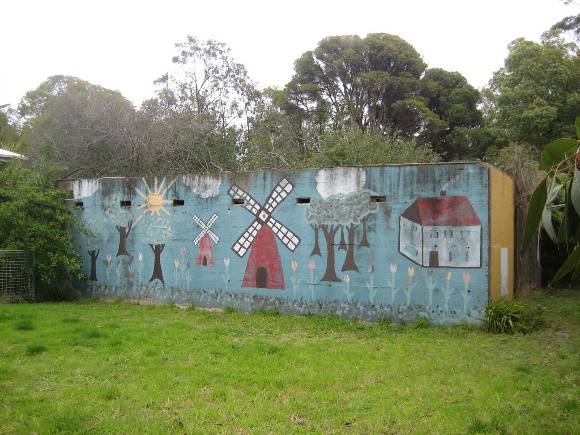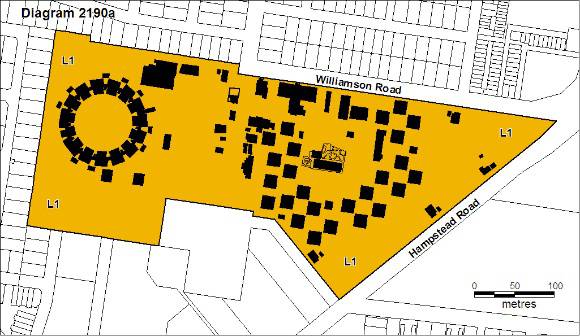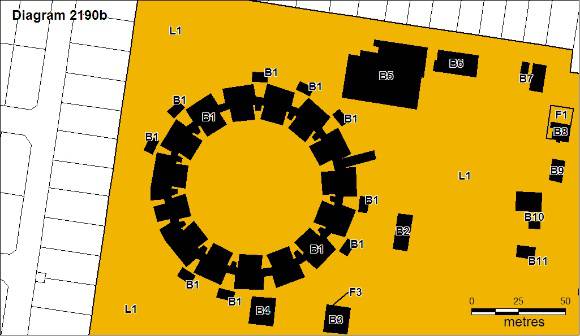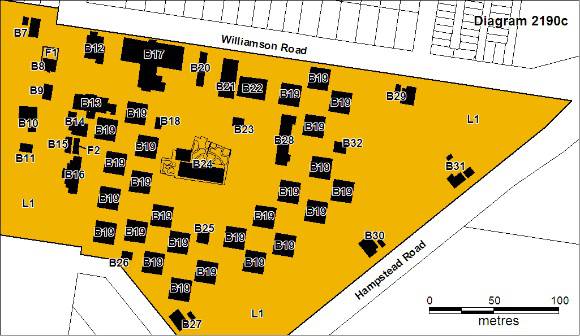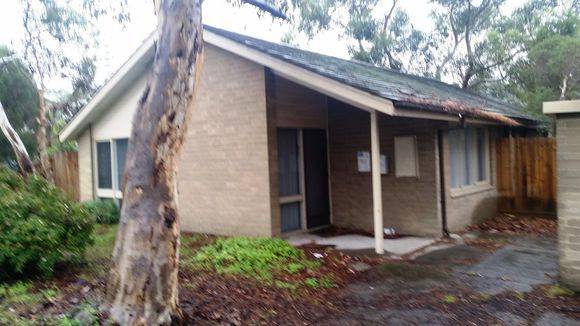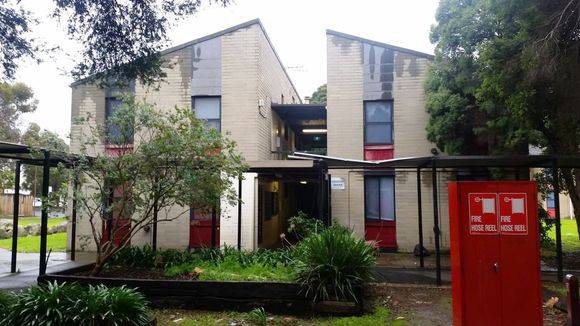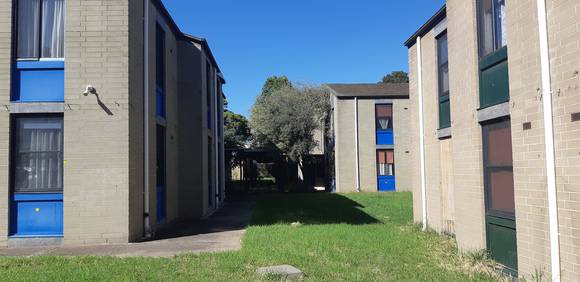| Back to search results » | Back to search page » |
|
FORMER MARIBYRNONG MIGRANT HOSTEL
Other NamesROMNEY HUT , FORMER PHILLIP (MARIBYRNONG) MIGRANT HOSTEL , NISSEN HUT , MIDWAY MIGRANT HOSTEL Location61-71 HAMPSTEAD ROAD MAIDSTONE, MARIBYRNONG CITY
File NumberFOL/16/36671-1LevelRegistered |
|
Statement of Significance
What is significant?
The former Maribyrnong Migrants Hostel located on the south side of Williamson Road in Maribyrnong consists of the remaining buildings associated with the New Pyrotechnics Section of the former Explosives Factory Maribyrnong (1942-1945), the Midway Hostel (1969) and the Phillip Centre (1971).
The site of the Former Maribyrnong Migrant Hostel includes that of the formerNew Pyrotechnic Section of the Explosives Factory Maribyrnong which was located to the north of Williamson Road. The New Pyrotechnic Section was established in 1942 to produce fuses, flares, tracers and smoke grenades and included 150 buildings built between 1942 and 1945. The New Pyrotechnic Section ceased production after World War II and thirteen buildings and some remnant infrastructure including a section of overhead steam supply piping remain from this period.
The site was then used as part of a Commonwealth Government immigration programme to resettle a large number of people from Europe, many of whom were 'displaced persons' whose lives had been disrupted by the war. The first group of post war migrants came as part of the Commonwealth Governments International Refugee Organisation scheme. More migrants, mostly British, came as part of government assisted passage programmes set up by the Federal government. The assisted migration programmes ceased in 1982.
The former Maribyrnong Migrant Hostel has accommodated migrants from almost every national group that has arrived in Australia since World War II. Initially these were people from Britain and Europe but the later migrants arrived from Asia and South America and people escaping political upheavals in places such as Hungary, Chile and Vietnam. The hostel at various times also accommodated naval personnel, apprentices and evacuees from Darwin after Cyclone Tracy in 1974.
The Maribyrnong Migrant Hostel was one of several postwar migrant hostels established in Melbourne. Migrants were initially accommodated in prefabricated structures, predominantly Nissen huts. The site includes a Nissen and a Romney hut. Nissen and Romney huts were not used in Australia during the World War II but thousands were used in postwar migrant camps. Most of the these huts were acquired from the British Ministry of Works and some from private dealers. The first Nissen huts arrived in Australia in 1949. They were replaced with the construction of the Midway Hostel in 1969 and the Phillip Centre in 1971.
The Midway Hostel complex comprises of twenty five two-storey accommodation buildings clustered into six groups. The buildings are constructed of concrete metric modular bricks with tile clad skillion roofs. In addition the Midway Hostel also included four laundry buildings, an English language school, a number of detached houses and a childcare centre with grass play areas and sand pits which was built in 1972. The buildings are currently occupied by Victoria University. The landscape of Midway Hostel is relatively bare but includes a number of scattered rockeries set in polygonal concrete paved 'islands'.
Constructed of concrete metric modular bricks in 1971, the Phillip Centre consists of two concentric rings of two-storey accommodation buildings separated by an internal two-storey walkway. Two accommodation buildings are located together each side of the internal walkway to form a pavilion. The circle is segmented into fifteen pavilions. The roofs are gabled and clad in thin flat concrete tiles. Between each pavilion on the ground floor walkway, small telephone rooms were provided for residents to keep contact with their home countries. On the outside of the ring, between each pavilion, laundry buildings and enclosed drying areas were provided. A landscaped garden was created inside the ring which was planted with native trees and shrubs. The accommodation units either looked out into this garden or out of the ring into the wider landscape.
Some units in the Phillip Centre included kitchens but most of the of the accommodation units did not have cooking facilities and food was provided in a communal dining room built as part of the late 1970s upgrade. Located above the servery in the dining hall is an illuminated map of the world showing the various time zones. The map also included clock faces showing the time at various places around the world but these have been removed. This dining room and kitchen were built to replace the former dining room which was a pyrotechnics building located on Williamson Road. The large Central Kitchen was also built at the same time to provide food for other Commonwealth Hostels Ltd operations. The Central Kitchen was burnt down in August 2007.
The place contains some remaining structures built for the Pyrotechnic Division which were subsequently used for various communal and administrative functions by the migrant hostel. These include a number of timber framed fibro and weatherboard clad structures, two brick stores buildings, an infirmary and a number of reinforced concrete bunkers which were later used for accommodation.
Attempts by migrants to personalise their surrounding are apparent in a mural of windmills and tulips by Dutch migrants painted on the side of one of the surviving concrete bunker structures and a mural of an Asian scene that appears to have been painted by Vietnamese migrants on a section of wall of one of the ammunition stores located next to the Phillip Centre. This building also includes a number of paintings by children on its walls. Staff of the migrant centre also erected a large aviary attached to the former electrical substation that was part of the pyrotechnic works.
The former Maribyrnong Migrant Hostel was also the headquarters of the Commonwealth Hostels Ltd which was initiated by the Commonwealth Government to assist with the operation of migrant hostels in Australia. Set up as a private company in October 1951, Commonwealth Hostels Ltd operated 64 hostels around Australia on behalf of the Federal Government. The hostels were run as a business, charging a tariff for board and lodging, set according to the migrant's working situation and the size of the family.
The Phillip Centre closed in 1986 and the Midway Hostel in 1987. The site was taken over by the Footscray Institute of Technology (now Victoria University of Technology) in 1989 to be used as student accommodation. The Phillip Centre became known as the Gilmour Centre and was used for student accommodation until 2001. It is no longer used. VUT continues to use the Midway Hostel as student accommodation.
The site was then used as part of a Commonwealth Government immigration programme to resettle a large number of people from Europe, many of whom were 'displaced persons' whose lives had been disrupted by the war. The first group of post war migrants came as part of the Commonwealth Governments International Refugee Organisation scheme. More migrants, mostly British, came as part of government assisted passage programmes set up by the Federal government. The assisted migration programmes ceased in 1982.
The former Maribyrnong Migrant Hostel has accommodated migrants from almost every national group that has arrived in Australia since World War II. Initially these were people from Britain and Europe but the later migrants arrived from Asia and South America and people escaping political upheavals in places such as Hungary, Chile and Vietnam. The hostel at various times also accommodated naval personnel, apprentices and evacuees from Darwin after Cyclone Tracy in 1974.
The Maribyrnong Migrant Hostel was one of several postwar migrant hostels established in Melbourne. Migrants were initially accommodated in prefabricated structures, predominantly Nissen huts. The site includes a Nissen and a Romney hut. Nissen and Romney huts were not used in Australia during the World War II but thousands were used in postwar migrant camps. Most of the these huts were acquired from the British Ministry of Works and some from private dealers. The first Nissen huts arrived in Australia in 1949. They were replaced with the construction of the Midway Hostel in 1969 and the Phillip Centre in 1971.
The Midway Hostel complex comprises of twenty five two-storey accommodation buildings clustered into six groups. The buildings are constructed of concrete metric modular bricks with tile clad skillion roofs. In addition the Midway Hostel also included four laundry buildings, an English language school, a number of detached houses and a childcare centre with grass play areas and sand pits which was built in 1972. The buildings are currently occupied by Victoria University. The landscape of Midway Hostel is relatively bare but includes a number of scattered rockeries set in polygonal concrete paved 'islands'.
Constructed of concrete metric modular bricks in 1971, the Phillip Centre consists of two concentric rings of two-storey accommodation buildings separated by an internal two-storey walkway. Two accommodation buildings are located together each side of the internal walkway to form a pavilion. The circle is segmented into fifteen pavilions. The roofs are gabled and clad in thin flat concrete tiles. Between each pavilion on the ground floor walkway, small telephone rooms were provided for residents to keep contact with their home countries. On the outside of the ring, between each pavilion, laundry buildings and enclosed drying areas were provided. A landscaped garden was created inside the ring which was planted with native trees and shrubs. The accommodation units either looked out into this garden or out of the ring into the wider landscape.
Some units in the Phillip Centre included kitchens but most of the of the accommodation units did not have cooking facilities and food was provided in a communal dining room built as part of the late 1970s upgrade. Located above the servery in the dining hall is an illuminated map of the world showing the various time zones. The map also included clock faces showing the time at various places around the world but these have been removed. This dining room and kitchen were built to replace the former dining room which was a pyrotechnics building located on Williamson Road. The large Central Kitchen was also built at the same time to provide food for other Commonwealth Hostels Ltd operations. The Central Kitchen was burnt down in August 2007.
The place contains some remaining structures built for the Pyrotechnic Division which were subsequently used for various communal and administrative functions by the migrant hostel. These include a number of timber framed fibro and weatherboard clad structures, two brick stores buildings, an infirmary and a number of reinforced concrete bunkers which were later used for accommodation.
Attempts by migrants to personalise their surrounding are apparent in a mural of windmills and tulips by Dutch migrants painted on the side of one of the surviving concrete bunker structures and a mural of an Asian scene that appears to have been painted by Vietnamese migrants on a section of wall of one of the ammunition stores located next to the Phillip Centre. This building also includes a number of paintings by children on its walls. Staff of the migrant centre also erected a large aviary attached to the former electrical substation that was part of the pyrotechnic works.
The former Maribyrnong Migrant Hostel was also the headquarters of the Commonwealth Hostels Ltd which was initiated by the Commonwealth Government to assist with the operation of migrant hostels in Australia. Set up as a private company in October 1951, Commonwealth Hostels Ltd operated 64 hostels around Australia on behalf of the Federal Government. The hostels were run as a business, charging a tariff for board and lodging, set according to the migrant's working situation and the size of the family.
The Phillip Centre closed in 1986 and the Midway Hostel in 1987. The site was taken over by the Footscray Institute of Technology (now Victoria University of Technology) in 1989 to be used as student accommodation. The Phillip Centre became known as the Gilmour Centre and was used for student accommodation until 2001. It is no longer used. VUT continues to use the Midway Hostel as student accommodation.
How is it significant?
The Former Maribyrnong Migrant Hostel is of historical and architectural significance to the State of Victoria.
Why is it significant?
The Former Maribyrnong Migrant Hostel is of historical significance for its associations with post World War II migration which contributed to the growth of Australia's multi cultural society in the second half of the twentieth century. This is particularly apparent in the surviving murals which respectively represent European and Asian migration.
The Former Maribyrnong Migrant Hostel site is of historical significance for its association with the New Pyrotechnic Section of the Explosives Factory Maribyrnong which played a vital part of the production armaments during World War II.
The Former Maribyrnong Migrant Hostel is of historical significance as the largest and only intact surviving purpose built post World War II migrant hostel in Victoria.
The Former Maribyrnong Migrant Hostel is of architectural significance as an extant example of buildings designed and built specifically as migrant accommodation.
The Nissen and Romney huts within the Former Maribyrnong Migrant Hostel are of architectural significance as the only prefabricated structures remaining. Although thousands of these structures were brought into Australia after World War II for migrant hostel accommodation, few are believed to survive.
The Former Maribyrnong Migrant Hostel is of historical significance as the largest and only intact surviving purpose built post World War II migrant hostel in Victoria.
The Former Maribyrnong Migrant Hostel is of architectural significance as an extant example of buildings designed and built specifically as migrant accommodation.
The Nissen and Romney huts within the Former Maribyrnong Migrant Hostel are of architectural significance as the only prefabricated structures remaining. Although thousands of these structures were brought into Australia after World War II for migrant hostel accommodation, few are believed to survive.
Group
Military
Category
Other - Military


